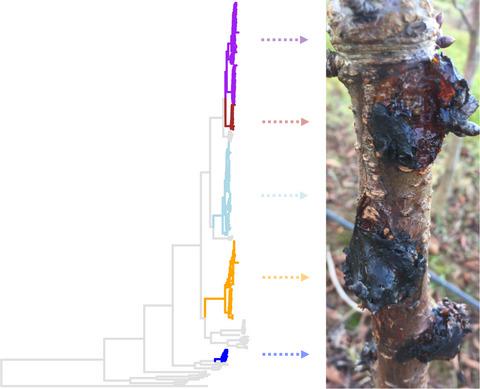当前位置:
X-MOL 学术
›
Plant Pathol.
›
论文详情
Our official English website, www.x-mol.net, welcomes your feedback! (Note: you will need to create a separate account there.)
Cherry picking by pseudomonads: after a century of research on canker, genomics provides insights into the evolution of pathogenicity towards stone fruits
Plant Pathology ( IF 2.7 ) Pub Date : 2020-05-06 , DOI: 10.1111/ppa.13189 Michelle T Hulin 1 , Robert W Jackson 2, 3 , Richard J Harrison 1, 4 , John W Mansfield 5
Plant Pathology ( IF 2.7 ) Pub Date : 2020-05-06 , DOI: 10.1111/ppa.13189 Michelle T Hulin 1 , Robert W Jackson 2, 3 , Richard J Harrison 1, 4 , John W Mansfield 5
Affiliation

|
Abstract Bacterial canker disease is a major limiting factor in the growing of cherry and other Prunus species worldwide. At least five distinct clades within the bacterial species complex Pseudomonas syringae are known to be causal agents of the disease. The different pathogens commonly coexist in the field. Reducing canker is a challenging prospect as the efficacy of chemical controls and host resistance may vary against each of the diverse clades involved. Genomic analysis has revealed that the pathogens use a variable repertoire of virulence factors to cause the disease. Significantly, strains of P. syringae pv. syringae possess more genes for toxin biosynthesis and fewer encoding type III effector proteins. There is also a shared pool of key effector genes present on mobile elements such as plasmids and prophages that may have roles in virulence. By contrast, there is evidence that absence or truncation of certain effector genes, such as hopAB, is characteristic of cherry pathogens. Here we highlight how recent research, underpinned by the earlier epidemiological studies, is allowing significant progress in our understanding of the canker pathogens. This fundamental knowledge, combined with emerging insights into host genetics, provides the groundwork for development of precise control measures and informed approaches to breed for disease resistance.
中文翻译:

假单胞菌采摘樱桃:经过一个世纪的溃疡病研究,基因组学提供了对核果致病性进化的见解
摘要 细菌性溃疡病是全球樱桃和其他李属植物生长的主要限制因素。已知细菌物种复合体丁香假单胞菌中至少有五个不同的进化枝是该疾病的病原体。不同的病原体通常在田间共存。减少溃疡病是一个具有挑战性的前景,因为化学控制的功效和宿主抵抗力可能因所涉及的每个不同的进化枝而异。基因组分析表明,病原体使用可变的毒力因子库来引起疾病。值得注意的是,P. syringae pv 菌株。丁香具有更多的毒素生物合成基因和更少的编码 III 型效应蛋白。还有一个共享的关键效应基因库存在于移动元件上,例如可能在毒力中起作用的质粒和原噬菌体。相比之下,有证据表明某些效应基因(如 hopAB)的缺失或截断是樱桃病原体的特征。在这里,我们强调在早期流行病学研究的支持下,最近的研究如何使我们对溃疡病病原体的理解取得重大进展。这一基础知识与对宿主遗传学的新见解相结合,为开发精确的控制措施和明智的抗病育种方法奠定了基础。在早期流行病学研究的支持下,我们对溃疡病病原体的理解取得了重大进展。这一基础知识与对宿主遗传学的新见解相结合,为开发精确的控制措施和明智的抗病育种方法奠定了基础。在早期流行病学研究的支持下,我们对溃疡病病原体的理解取得了重大进展。这一基础知识与对宿主遗传学的新见解相结合,为开发精确的控制措施和明智的抗病育种方法奠定了基础。
更新日期:2020-05-06
中文翻译:

假单胞菌采摘樱桃:经过一个世纪的溃疡病研究,基因组学提供了对核果致病性进化的见解
摘要 细菌性溃疡病是全球樱桃和其他李属植物生长的主要限制因素。已知细菌物种复合体丁香假单胞菌中至少有五个不同的进化枝是该疾病的病原体。不同的病原体通常在田间共存。减少溃疡病是一个具有挑战性的前景,因为化学控制的功效和宿主抵抗力可能因所涉及的每个不同的进化枝而异。基因组分析表明,病原体使用可变的毒力因子库来引起疾病。值得注意的是,P. syringae pv 菌株。丁香具有更多的毒素生物合成基因和更少的编码 III 型效应蛋白。还有一个共享的关键效应基因库存在于移动元件上,例如可能在毒力中起作用的质粒和原噬菌体。相比之下,有证据表明某些效应基因(如 hopAB)的缺失或截断是樱桃病原体的特征。在这里,我们强调在早期流行病学研究的支持下,最近的研究如何使我们对溃疡病病原体的理解取得重大进展。这一基础知识与对宿主遗传学的新见解相结合,为开发精确的控制措施和明智的抗病育种方法奠定了基础。在早期流行病学研究的支持下,我们对溃疡病病原体的理解取得了重大进展。这一基础知识与对宿主遗传学的新见解相结合,为开发精确的控制措施和明智的抗病育种方法奠定了基础。在早期流行病学研究的支持下,我们对溃疡病病原体的理解取得了重大进展。这一基础知识与对宿主遗传学的新见解相结合,为开发精确的控制措施和明智的抗病育种方法奠定了基础。



























 京公网安备 11010802027423号
京公网安备 11010802027423号